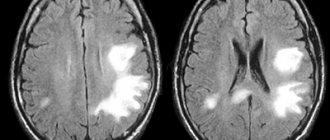Medical characteristics of hysteria
Hysteria is a mental disorder that manifests itself in various vegetative and affective deviations from the norm. Changes in behavior are dictated by the patient’s desire to attract the attention of others by any means.
The term “hysteria” is no longer used in psychology. Initially, hysteria was understood as a specific disease; today this term combines several forms of deviations:
- histrionic personality disorder (HPD);
- conversion violations;
- anxious hysteria, etc.
Symptoms
Patients experience strong mood swings - from elation to depression and despair. Patients are egocentric, suggestible, and always want to be the center of attention of others. They are distinguished by eccentric behavior and unusual appearance. The development of the disease entails changes in a person’s physical well-being. Restless patients are diagnosed with a number of sensory, motor and somatic disorders.
Histrionic personality disorder (HPD) is characterized by the manifestation of a number of behavioral characteristics:
- increased emotionality;
- theatricality of actions;
- the desire to be the object of everyone's attention;
- excessive sociability;
- anxiety about one's own attractiveness;
- desire to manipulate people;
- inability to objectively evaluate one's own actions.
In more severe forms of the disease, patients experience severe symptoms such as loss of sensation in areas of the body, paralysis, tremors of the limbs, blindness or muteness. A change in consciousness occurs, and amnesia becomes a frequent accompaniment of hysterical disorders.
Hysterical attack
An acute form of mental illness is a hysterical attack. A sudden attack is characterized by a violent manifestation of emotions: a violent patient hits his head, screams, cries, tears his hair and clothes, and bends over.
An attack can be triggered by an unusual situation - bad news, an unpleasant event, a quarrel, failure to comply with the patient’s whims.
Before an attack, a person complains that he feels dizzy or has dark vision. However, the cause of the seizure is not physiological processes.
It is usually staged and completely controlled. From the outside, a hysterical attack is similar to an epileptic attack, but:
- the hysterical person remains conscious, he knows how to fall “correctly” so as not to get injured;
- the patient controls physiological processes, does not allow involuntary urination, defecation and other situations accompanying an epileptic seizure.
The purpose of a hysterical attack is to gain attention. If there is no expected reaction from the public, the seizure ends and the person calms down.
Stopping a seizure is not difficult. The person will be brought to consciousness:
- loud voice;
- cold water;
- physical impact.
The theatricalization of attacks is caused by the appearance of vivid hallucinations that replace reality. In psychiatry, this condition is called the hysterical twilight state. It can be short-term or last a long time.
In severe cases, the patient is unable to answer simple questions or solve a simple mathematical equation. The person is disoriented in space, indifferent to what is happening around him. This condition is called Ganser syndrome.
After the end of the seizure, the patient, as a rule, experiences temporary amnesia; he cannot remember the events that happened to him.
Diagnosis and treatment of hysteria
Patients with hysterical disorders like to imitate various diseases. By demonstrating their painful condition to others, they themselves eventually begin to believe in fictitious diseases. This feature helps diagnose hysteria. A medical examination reveals the inconsistency of the patient’s complaints. Consultation with a psychiatrist is necessary for a correct diagnosis.
The treatment of hysteria consists in correcting the patient’s psyche. The psychotherapist, using suggestion, helps the patient learn to perceive himself and the world around him.
Occupational therapy helps combat the manifestations of hysteria.
Drug treatment involves the use of drugs based on medicinal herbs (valerian, motherwort) to reduce excitability.
Hysteria according to Z. Freud
For a long time, hysteria was diagnosed only in women. Cases of male hysteria were first recorded by the French neurologist J. Charcot, then studied by the famous psychologist Z. Freud. In his research, a description of the disease appeared for the first time.
Freud considered the cause of hysteria to be the manifestation of the subconscious, unsatisfied desires hidden in it. He believed that the prerequisites for the disease were hidden in childhood traumas and unpleasant events that influenced the development of personality during growing up. The cause of hysteria, according to Freud, is also associated with sexual complexes. Therefore, the first manifestations of hysterical disorders are observed in childhood or adolescence.
The case of Anna O.
The case history of Bertha Pappenheim, known under the pseudonym Anna O., influenced the development of psychoanalysis in the method of S. Freud.
A young intelligent girl suffered from hysteria, she had the following symptoms: impaired vision and speech, paralysis, mental disorders, memory loss.
The girl’s attending physician, Joseph Breuer, used hypnosis for treatment. Immersed in a special state, Anna recalled the events that had traumatized her. Breuer discussed these memories with Anna, and after the conversations the girl’s mental state improved. She experienced her sessions with Breuer as “cleansing” through “healing conversations.” Hypnosis and subsequent conversation freed the patient’s consciousness from thoughts and memories that tormented her, thereby weakening or completely eliminating the symptoms of the disease.
More than 9,000 people have gotten rid of their psychological problems using this technique.
Breuer did not cure Anna O.; the girl was placed in a hospital, where she received treatment traditional for those years. But the case history described by Breuer played an important role in the development of psychoanalysis.
Breuer discussed cases from his practice with S. Freud, a colleague and close friend. Having studied the history of the disease, Freud came to begin to explore the mechanism of neuroses. Breuer's practice discovered for Freud the method of therapeutic conversation with the patient and the method of catharsis. He used this in his practice, replacing hypnosis with suggestion, and then with the method of free association.
The cathartic method is used in modern practice to treat hysteria. It allows the patient to remember and relive the events that became the source of the trauma.
Scientific research
P. Janet and J. M. Charcot began to study this disease. Under the influence of the latter, S. Freud and J. Breuer began studying the mental mechanisms of hysteria. Z. Freud made a huge contribution to the development of such a phenomenon as hysteria. He saw treatment in a new method he invented - psychoanalysis. The psychologist also identified the psychological defense mechanisms that we need in the event of an internal conflict. This is repression, identification, transference, denial. Z. Freud said that if mechanisms cannot eliminate the conflict, hysteria sets in. He also saw the reasons in repressed ideas and memories, which are of an erotic nature and are expressed in bodily symptoms.
In general, S. Freud had his own developed classification of psychoneuroses. He distinguished hysterical neuroses and obsessional neuroses. They differ from fear neurosis, since the latter occurs after an unsuccessful erotic experience, but psychoneuroses are provoked by conflicts in early childhood.
Manifestation of hysteria in women
According to statistics, women more often suffer from hysterical disorders due to physiological and behavioral characteristics.
From a physiological point of view, the development of hysteria is influenced by hormonal changes. Minor fluctuations during the menstrual period are not dangerous; they only affect the woman’s well-being. Hormonal surges during puberty, the postpartum period and the onset of menopause often cause mental disorders, including hysterical disorders.
Behavioral characteristics are associated with a woman’s unconditional desire to arouse admiration or envy, to attract attention. In addition, women are more excitable, they are characterized by nervousness and irritability.
Psychologists associate the emergence of factors leading to the development of the disease in women with the use of incorrect psychological attitudes in childhood. Girls develop a false idea of gender inequality, the family and the role of women. Often there is suppression of sexual desires, which do not disappear, but take the form of affect.
Hormonal changes during puberty negatively affect the female psyche, exacerbating the preconditions for the occurrence of hysterical disorders.
Women with hysterical disorders are characterized by infantilism, which is manifested by a number of behavioral features:
- immaturity of judgment;
- inability to adequately perceive criticism;
- inability to critically evaluate one's own behavior;
- susceptibility to suggestion from third parties.
The peculiarity of the course of the disease in women is expressed in the variability of symptoms.
Psychological protection
The main types of protective psychological mechanisms include identification, regression and repression. With their help, the psyche tries to cope with childhood conflicts and suppresses unconscious fantasies, lowering them below the level of consciousness. In this way the personality maintains its integrity.
The syndromes differ in the individual characteristics of a disease such as hysteria. The treatment consists of using psychotherapy to identify the pathogenic pattern. Internal conflicts also influence the formation of personality. If the disease does not manifest itself, then the formation of a hysterical character may simply occur. Theatrical demonstrativeness, flirtatiousness, labile mood, a tendency to react with unconscious fantasy - this is hysteria. Women also express a fear of sexual contacts in the presence of blatantly defiant behavior.
Manifestation of hysteria in men
The disease is diagnosed using the same signs as in women.
Many years of experience in studying the nature of the disease in men made it possible to identify specific symptoms:
- rapid mood changes from crying to nervous laughter;
- feeling of lack of air;
- arrhythmia;
- frequent dizziness and headaches;
- “staggering” gait;
- feeling of a lump in the throat.
The causes of the disease in men are closely related to certain character traits of the patient. Increased emotionality and infantilism lead to changes in behavior. Common factors in the development of the disease in men are abuse of alcohol, narcotic and psychotropic substances. The patient’s psyche is also affected by dissatisfaction with professional activities and difficult relationships in the family.
Uterine rabies and hysteria in the 19th century
The name of the disease comes from the ancient Greek word meaning “uterus”. For the first time, a description of hysteria appears in Hippocrates; in the writings of Plato, the disease is characterized as “rabies into which the uterus of a woman who is unable to conceive falls.” The disease received a second name - “uterine rabies”. The ancient Greeks believed that the uterus could move freely throughout a woman’s body, entering the heart, brain and other parts of the body, causing changes in behavior and consciousness, and insanity.
The manifestation of symptoms of hysteria in the Middle Ages was associated with demonism. Women could be burned at the stake, accused of being associated with “evil spirits,” and Catholic priests practiced exorcism rites to expel demons from the womb.
In Russia, the idea of women being possessed by demons was closely connected with the concept of “hype”. “Cliquers” are known for involuntarily screaming incoherent phrases during church services, and often having hysterical fits. The behavior of restless women was explained by the influence of demons that possessed them.
In the 19th century, primitive ideas about the nature of the disease gave way to common sense. But doctors continued to link the nature of the disease with the effects of the uterus. Until the beginning of the 20th century, treatment was based on the physiological effect on the disease.
Most of them were harmless and were aimed at satisfying the woman’s physical needs, including through genital massage. There are known cases when cruel methods were used to solve the problem: electric shock, partial or complete removal of female organs, cauterization with acid and others.
At the beginning of the 20th century, medicine made a breakthrough in the treatment of mental disorders. Numerous studies have helped to understand the characteristics of the disease and select humane treatment methods.
Prevention of hysterical attacks
Oddly enough, to prevent this disorder, excessive care and guardianship are not at all necessary, because the hysteric, having caught this, can begin to feign illness and benefit from his condition. Those close to you need to accept a state of adequate perception with slight ignoring. In this case, either hysterical attacks will disappear altogether, or the level of their demonstrativeness will decrease.
After a visit to a specialist, you should regularly take psychotropic medications and drugs that calm the nervous system. You can drink tea and tinctures of various herbs.





